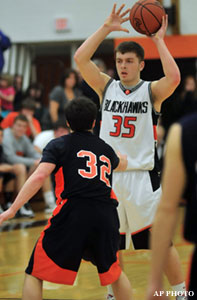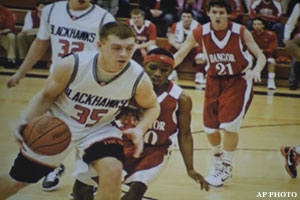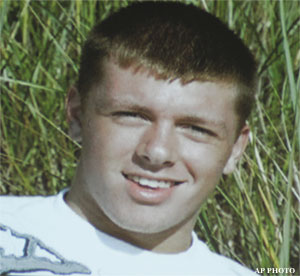The season is over, the cameras have left. Other stories have captured the hearts of the country.
All that’s left in Fennville, Mich., are the memories. The nightmarish memories of how high school basketball star Wes Leonard collapsed on the court and died shortly after hitting a game-winning shot on March 3.
There was panic and helplessness in Fennville that awful night. But there were no immediate answers. The cause of death was dilated cardiomyopathy, or an enlargement of the main pumping chamber of the heart.

But could anything have been done to prevent it?
Leonard’s death got a great deal of media coverage, but what most don’t know is that four more teen athletes, all competing in the sports they loved, died over the next 10 days.
At least three of those athletes, like Leonard, died of heart-related issues.
Matt Hammerdorfer, a 17-year-old rugby player and junior at Fort Collins (Colo.) Poudre, died March 5 during a match after taking a hit to his chest. His death was attributed to cardiomegaly and biventricular hypertrophy. (The Mayo Clinic describes cardiomegaly as an enlarged heart and hypertrophy as the thickening of the muscle in the heart’s pumping chambers.)
Javaris Brinkley, a 16-year-old basketball player and student at Gaston (N.C.) College Preparatory, died March 8 after a recreational game at a local church. His death was simply described as “heart failure.” A specific cause of death has not yet been determined.
Robert Garza, a 16-year-old Roma (Texas) High basketball player, died March 12 while competing in an AAU game. Preliminary autopsy results show an enlarged heart. More specific information isn’t expected for another six weeks.
According to reports in local newspapers, both Hammerdorfer and Brinkley were aware that they had heart conditions. Leonard and Garza, on the other hand, were not.
The cause of death for 17-year-old Gainesville (Fla.) Eastside soccer and track athlete Sarah Landauer, who died March 9 after collapsing after a run two days earlier, has not yet been officially been determined. According to a report in the Gainesville Sun, Landauer had collapsed in another track practice in late February but had been cleared by doctors to participate in athletic activity.
So many causes. So many triggers. Some knew about their conditions. Some didn’t. And they’re all lumped together in the category of “sudden cardiac arrest.”
Why have we been unable to figure out what’s behind sudden cardiac arrest? Why haven’t we been able to prevent it?
Why are so many high school athletes dying?
There is some good news.
Dr. Thomas Rowland, a noted pediatric cardiologist with Baystate Medical Center in Springfield, Mass., says not only are there a multitude of causes for sudden cardiac death but -- despite these recent events -- it happens very infrequently.
“When you have an event that’s so dramatic and so tragic, it captures everyone’s attention,” he says. “But when you look at the number of cases, it’s still really not common.”
Dr. Rowland recently published an article titled “Prevention of Sudden Cardiac Death in Young Athletes: Controversies and Conundrums.” In the article, Dr. Rowland writes that a teen is about 500 times more likely to die in a car accident than while playing sports.
By his estimation, anywhere between 12 and 40 teens die each year while participating in sports. Consider that against the more than 7.6 million high school students that participated in athletics during the 2009-2010 school year as reported by the National Federation of State High School Associations (NFHS).
“The reality is that even if these events are underreported, the risk is still incredibly small,” he says.
Other reports tend to back Dr. Rowland’s opinion.
A report issued by the American Heart Association in 2009 showed that 76 athletes died from sudden cardiac arrest in 2006 – and that included all athletes between the ages of 8 and 39.

“So in one sense, that should be good news,” he says.
The bad news is that Dr. Rowland also reported eight different heart ailments that commonly triggered sudden cardiac death in young athletes in the United States -- including those that are known to have been a factor in the deaths of Leonard and Hammerdorfer.
Those factors -- the numerous triggers and the infrequency of the events –- combined with privacy laws, have led to problems for researchers.
“For the average doctor, it’s very hard to get data,” Dr. Rowland says. “We still need to collect and get good information from all over.”
So while the demand for answers spikes, the answers only scatter.
In the days following each teen’s death, message boards on multiple websites were littered with the same outcry.
EKGs should be required as part of athletic physicals, readers wrote.
And while Dr. Rowland doesn’t necessarily disagree, he says the answer isn’t that simple.
“This is a point of great controversy,” he says. “There are so many gray areas and uncertainties.”
The problem with electrocardiograms, or EKGs as they are more commonly known, is that some seemingly healthy athletes would have abnormal readings or borderline findings. That would then, in turn, lead to additional testing -- which may or may not show a more significant problem.
“Sometimes even after further evaluation, we still can’t tell,” Dr. Rowland says.
Some athletes could be disqualified from competition unnecessarily. And the financial costs of doing additional tests on an athlete with a borderline EKG reading are also high, especially in the case of an athlete does not have health insurance.
That’s why, because of the rarity of the instances of sudden cardiac death, the costs of requiring EKGs tend to outweigh the benefits.
The American Heart Association took the same stance in 2007, issuing a statement that due to the cost, the false-positive readings and the lack of medical resources (meaning the lack of a national standard of qualified medical professionals performing physicals), that EKGs were not recommended to be a mandatory part of a standard pre-participation athletic physical.
And a new study published in the Journal of the American College of Cardiology concludes that sudden cardiac deaths are no less likely in nations such as Italy that mandate EKG testing.
That means any real change may be up to those who have lost the most already.
John Stewart was a standout basketball player at Indianapolis (Ind.) Lawrence Central in 1999 when he collapsed on the court during a state playoff game. He was 18.
The cause of his death was later determined to be hypertophic cardiomyopathy, or HCM, the most common cause behind sudden cardiac death. HCM, according to Dr. Rowland, is best described as a muscle-bound heart.
“The wall thickness (of the heart) can be three to four times thicker than usual,” he says.
It was an ailment neither John Stewart nor his mother realized he had.
Feleica Stewart says her son had a promising basketball career ahead of him before his death.
“He was being recruited so much, he had to have his own phone number,” she says. “He ended up signing his Letter of Intent to Kentucky.”
After her son’s death in 1999, Feleica established The John H. Stewart Foundation in early 2000, with the hopes of bringing awareness to sudden cardiac arrest.
She says learning of the news of the death of Wes Leonard and the other teens in recent days added motivation to her mission.
“It made me cry,” she says. “It feels like I’m not doing enough to help people realize the
importance of early detection.”
Through the assistance of Indiana University Health and Clarian Health as well as doctors volunteering their time and expertise, the foundation has been able to offer sophisticated heart screenings to teens at little to no cost to the families.
On March 14, the foundation set up an echocardiogram (commonly referred to as an ECHO) screening at Fishers (Ind.) Hamilton Southeastern. About 60 athletes were screened for a very minimal fee.
“We need to get these into places where kids don’t have health insurance,” Stewart says. “A lot of times those are the most highly athletic kids.”
She’s also planning to distribute information at both the men’s and women’s NCAA Final Four events in Houston and Indianapolis, respectively, and she’s worked with University of Minnesota head basketball coach Tubby Smith on producing public service announcements about the importance of screening.
“It’s hard on the family, the school, the community,” she says. “We want to extend these kids’ lives out to allow them to grow to become old people.”
But for that to happen, the most important step may have nothing to do with screening.
In 2008, a survey was sent out to 500 Minnesota high schools. The results were surprising.
“Sixty percent of the schools said they had no plan in place after school hours,” says Jody Redman, the associate director for the Minnesota State High School League (MSHSL). “So after the school office was closed, there was nothing.”
The survey spawned a unique program focused on two steps: putting an automatic external defibrillator (AED) in every high school in the state, and developing a plan for responding to sudden cardiac emergencies.
The program, titled “Anyone Can Save a Life,” was among the first of its kind in the nation, Redman says.
“Coaches often times are standing by themselves (in these situations),” Redman says. “This allows coaches to empower students to action.”
The program requires coaches to spend 10 minutes or so at the beginning of each team’s season asking questions of his/her team. How many of the student athletes have been trained in CPR? Would they be willing to assist if needed?
From there, at least two other students are assigned to call 911. Other students are assigned to run to the athletic trainer’s office, while still more head to a pre-determined location to meet an ambulance. Two students are assigned to know where the nearest AED device is and to go retrieve it.
“That empowers the coach to be with the victim without having to give direction,” Redman says.
After those assignments have been made, the coach fills out a worksheet, which is kept on record in the school’s athletic office. Teams revisit the plan two to three times per season.
And while this may seem like just one more thing to add to a coach’s plate, Redman says most coaches understand the importance of having a plan in place.
“The chances of having a positive outcome far outweigh having more to do,” she says.
And, she says, the program is working.
“At one high school, a coach filled out the worksheet on Friday,” Redman says. “On Monday, a girl had a seizure during practice and everything ran like clockwork. School officials and parents … everyone was surprised at how smoothly the situation was handled.”
The program has been implemented at absolutely no cost to each high school in the state, thanks in part to the help of medical equipment maker Medtronic. The creation of the program was funded through a grant, while the MSHSL Foundation provided money to schools to purchase AEDs.
This fall, Redman said the program will be expanding, requiring all head coaches to undergo training in the “Anyone Can Save a Life” curriculum.
Minnesota has also offered the program, including the binders with worksheets and instructions, to any high school association in the country, free of charge.
Randy Gillary wasn’t there on April 1, 2000.
He wasn’t sitting poolside that morning, watching his daughter compete as the Troy (Mich.) Athens water polo team faced off in a doubleheader at Beverly Hills (Mich.) Groves.
Randy’s wife, Susan, wasn’t there either. She was out running errands, just like any normal Saturday.
So when 15-year-old Kimberly Gillary -- known as Kimmy to her family and friends -- began to feel lightheaded during the match and asked to come out of the game, he wasn’t there to see her collapse on the deck of the pool.
Randy Gillary said, in hindsight, it was probably better that way. It would have been too difficult to watch.
But he was most certainly there two days later on April 3, after he and his wife and their three other daughters made the decision to take Kimmy off life support in a local hospital, when she died.
“Normally that would have been a difficult decision,” he says, reflecting back on the day. “But it really wasn’t in this case. … Her systems were deteriorating.”
Kimmy died of sudden cardiac arrest due to an enlarged heart.
“We didn’t know of the problem,” Gillary said. “There was no history on either side of the family.”
Deep down inside, Gillary suspects that two very strong viral illnesses that Kimmy suffered while she was younger may have played a role in the heart ailment. But he’s never had that medically confirmed.
What he does know, however, is that his young, athletic daughter died that April morning of sudden cardiac arrest.
“We basically lost Kimmy on the pool deck,” he says. “It’s left a big hole in our family.”
The day after Gillary’s death, the family established the Kimberly A. Gillary Foundation, dedicated to helping to place AEDs in all high schools in the state of Michigan.

Since 2000, Randy Gillary said the foundation has raised $1.1 million and has placed 550 AEDs in schools throughout the state.
He’s also currently working with the Michigan state legislature to permanently designate April as Michigan Student Athlete Cardiac Awareness Month, both in memory of his daughter and now Wes Leonard (right).
The foundation’s next goal is twofold -- to make a change to Michigan high school curriculum to require students to learn both CPR and how to operate an AED, as well as have mandatory AED drills.
“It’s one thing to have a trained staff but another to have a practiced staff,” Gillary says. “We think that’s critical.
“Hopefully lessons can be learned from tragic incidents. Do we know what to do? That’s what I’m hoping.”
The next Wes Leonard is out there somewhere, dribbling and dreaming of hitting the big shot in the big moment.
The race is on to save him.
Carla Swank is the assistant editor of RivalsHigh (www.rivalshigh.com), the national high school sports website for Yahoo! Sports. She can be reached at cswank@yahoo-inc.com.




